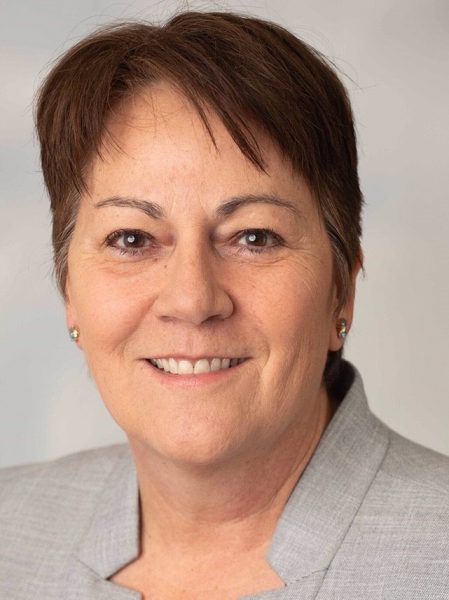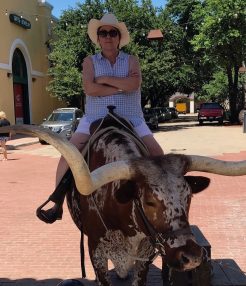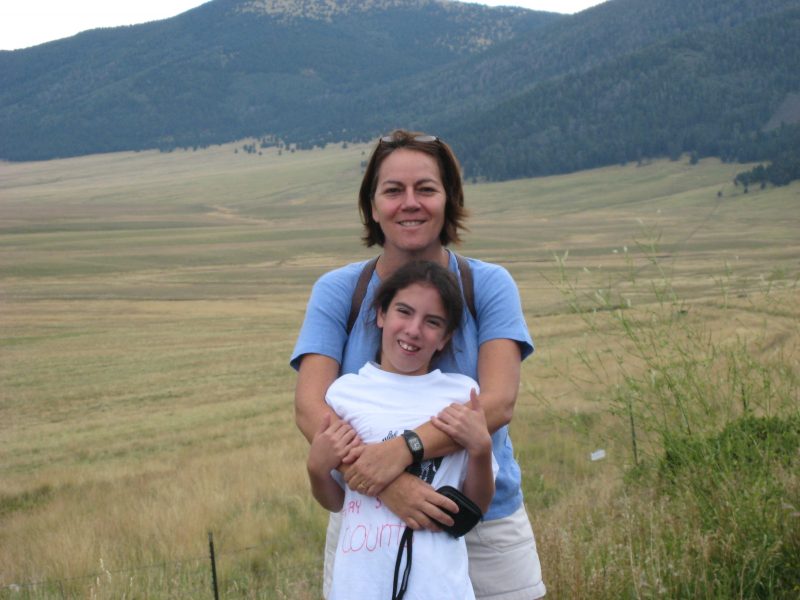Claudia Mora: Dean
November 12, 2020

By Monica Kortsha
In February 2020, Claudia Mora became the dean of the Jackson School of Geosciences. Mora has had a varied career in geosciences — serving as a division leader at Los Alamos National Laboratory and as the head of the geology department at the University of Tennessee, Knoxville. As dean, she envisions an environment where students can cultivate skills no matter where their careers take them.
When Claudia Mora joined the Jackson School of Geosciences in spring 2020, she hit the ground running. The coronavirus pandemic closed The University of Texas at Austin campus during her second month on the job. The situation meant guiding the Jackson School through the online transition.
It was a hectic start. But Mora has had plenty of experience working in high-stakes situations. Before accepting the position as dean at the Jackson School, she served as the deputy division leader of Los Alamos National Laboratory’s Chemistry Division, where a key scientific focus is detecting nuclear weapons material as it’s moved around the globe.
But what brought Mora to the Jackson School in the first place was its breadth and depth of research and the education it provides students at all stages. A former department head in geology at the University of Tennessee, Mora has experience in both academic and independent research environments. This complements the unique structure of the Jackson School, which blends academics with research groups across three distinct research units.
“Joining this community is a tremendous opportunity,” she said. “The educational experiences our students receive are excellent, the research is world-class, and the collective impact of the community is remarkable.”
Throughout her career, Mora has been keenly aware of the diversity of pathways offered by the geosciences. She said her guiding principle has been to build up the skills that would provide different options — and then keep an eye out for opportunities to leverage those skills.
“It’s important to be resilient in your career and life, and to be able to adapt to changes that you may — or may not — anticipate,” Mora said. “Because big changes happen, and the world doesn’t stop for you to catch up. So, being able to learn new things on the fly and to conceive how to use your skills towards a new problem or in a new position are very important.”
Mora said her interest in geosciences started with a fieldmapping trip with her older sister, who studied geosciences and went on to have a career in the oil and gas industry.
Mora was in her freshman year at The University of New Mexico, when the pair went mapping on Canjilon Hill, just north of Albuquerque. Mora said she left the field with a new perspective on a familiar landscape.
“I thought it was really cool that you could actually look at the landscape and understand it,” she said.

The experience inspired her to take a geology class, and from there, she was hooked. As an undergraduate, she conducted research on the geochemistry of the Grants mineral belt, the main source of uranium in New Mexico. Mora continued geochemistry research into graduate school, investigating geochemical processes in metamorphic settings.
She earned a master’s at Rice University in 1983, where she studied the metamorphic petrology of the Oaxacan Complex. At the University of Wisconsin-Madison, her doctoral research focused on fluid-rock interaction from a field site at the edge of the Idaho Batholic.
Even when pursuing her graduate research, Mora kept the door open to other opportunities. While at Rice, she took a summer job with Gulf Oil, where she wrote descriptions of offshore basins based on Portuguese documents from Petrobras, a Brazilian oil company. Mora’s knowledge of Spanish, a similar language, enabled her to carry out the translation work and the scientific synthesis.
As a doctoral student, Mora had an adviser who recommended that each student have “three tricks” — three distinct skills that students could leverage during their careers. So in addition to her primary work on stable isotope analysis, Mora took extra classes in crystallography and petrology. She also earned a minor in chemistry, which fulfilled a university requirement that doctoral students have a minor field of study.
When Mora earned her Ph.D. in 1988, being a woman in geosciences — let alone a Latina — was rare.
The first job Mora landed was as a visiting professor through a program dedicated for minority researchers. But Mora found that it created barriers by placing researchers on a nontenure career tract for a number of years. While Mora is grateful that the program provided a means for her to improve her teaching and to secure her first research grant from the National Science Foundation, she ended up leaving as soon as she could, accepting a position as an assistant professor in the geology department at the University of Tennessee in 1989.
Mora said that her experience has made her work vigilantly to ensure that diversity programs help people in the long run.
“I’ve been careful with programs ever since to make sure that people are actually being helped,” Mora said.
It’s a perspective that Mora is putting to work as the Jackson School revamps its own diversity efforts.
At Tennessee, Mora was the first woman and first minority on the geology faculty. A few years into the job, she would be the first faculty member on the tenure track to give birth. She was also the university’s first stable isotope geochemist.
“That’s probably the best thing that ever happened to me, frankly, because I had a lot of freedom to use isotopes in any way I could get funded,” Mora said.
Stable isotope analysis is a technique that can detect chemical signatures across a number of materials and environments. Although she had worked alone up until that point, the technique became a means of collaborating with experts in a number of other geosciences.
Her first collaborative project investigated oxygen and carbon in paleosols with her colleague Steven Driese. It was among the first studies to use stable isotopes to investigate ancient levels of carbon dioxide in the atmosphere, with the results showing a large drawdown of carbon dioxide associated with the explosion of plant life that occurred between 300 million and 400 million years ago.
This work set the stage for other studies that applied Mora’s stable isotope analysis to a number of other areas. One of the most notable involved using oxygen isotopes preserved in tree rings to create a proxy record for hurricanes, which generate rainstorms that are unusually depleted of heavy oxygen isotopes.
Years of collaboration have created a unique research record that spans geoscience disciplines.
“I’m kind of proud, in an odd sort of way, that my three highest cited papers are in three fundamentally different areas: the paleosol research, dendroclimatology, and fluid rock interaction at high temperature,” Mora said.
Mora rose through the ranks at the University of Tennessee, and in 2002, 13 years after she arrived, she became head of the geology department.
But Mora’s career track changed in 2007, when her husband accepted a job at Los Alamos National Laboratory. Back in New Mexico, she had to revise her research focus and had to build a new career. During this time, she did professional service on the National Science Foundation Geosciences Advisory Committee, National Research Council Board on Earth Sciences and Resources, and as a councilor for the Geological Society of America.
“I discovered, as I served as department head or worked on professional panels, that I liked to create environments for science, to try to direct people towards collaborations in science that would do good things,” Mora said. “I didn’t have to be the one to do the science. I didn’t need to have the credit for the science being done. I just wanted to facilitate good science being done.”
Mora turned her focus to cultivating research environments where science could thrive. And in 2010, she became the group leader of the Los Alamos Earth Observation Group, a broad group with projects that spanned from fracture systems, to monitoring tree mortality, to measuring melting permafrost.

In 2016, Mora served as the president of the Geological Society of America. And after seven years leading the Earth Observation Group, Mora became the deputy division leader of the Los Alamos Chemistry Division — her most recent position before the Jackson School.
Sharon Mosher, the Jackson School’s former dean, said that Mora’s broad experience at research institutions and geoscience organizations will serve the Jackson School well.
“Claudia was a great choice for dean of the Jackson School,” she said. “With her experience holding leadership roles both in academia and at a national lab, she has the experience and skills to take the Jackson School to new heights.”
Research at Los Alamos is centered on mission-driven science, with projects working toward a specific goal, some focusing on long-term challenges and others on a short-term time frame. Mora is interested in cultivating a similar mindset at the Jackson School.
“It really does jive with the Jackson School’s mission statement, which says that we conduct research and discover knowledge for the benefit of society,” Mora said. “Applied-, mission-driven or mission-inspired science can coexist with basic research.”
At the same time, she wants students at the Jackson School to hone their skills that will serve them on that mission — wherever it takes them. Mora’s doctoral adviser talked about “three tricks.” But Mora’s preferred analogy is collecting bricks, with each brick being a skill or experience cultivated during graduate school or through a professional career. In her mind, it’s better to use them to build roads to new places than wall yourself in.
“When the bricks fall down and go all over the place, then the question is, can you then find a path forward,” Mora said. “Can you lay them out in way that gets you to a new place?
Back to the Newsletter